In 2007, ABC Organic Gardener magazine editor, Steve Payne, and Russ Grayson were approached by New Internationalist magazine to write a brief history of the permaculture design system, with particular focus on its formative years.
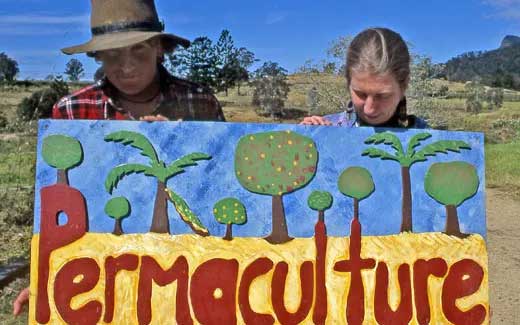
An edited version of their article appeared in the magazine. This is the article supplied to New Internationalist…
1972-1976 — the formative years
THE STORY OF PERMACULTURE begins in the early 1970s in Tasmania, Australia.
There, it starts with two men – a teacher and student. But let’s go back before they got together, back to their formative years, for it is here that we find the influences that set those two on a course that would intersect… a course that would create something new from the social and political turmoil of that decade.
Origins – Bill Mollison
Bill Mollison was born in 1928 in the small fishing village of Stanley, on the Bass Strait coast of cool-temperate Tasmania.
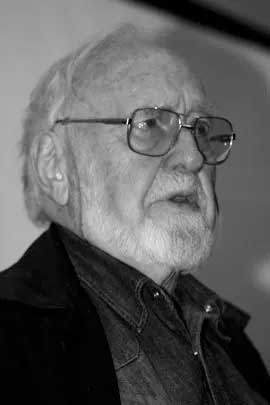
Bill Mollison in 2008
He left school at 15 to help run his family’s bakery. Among the jobs that followed were mill worker, seaman, animal trapper and shark fisherman. A rough brew for someone who would become an environmentalist, they led him to nine years at the Wildlife Survey Section of the CSIRO (Australia’s government science research organisation) and then time with the Inland Fisheries Commission of Tasmania. What the two latter jobs provided were long stints in the wild forests and coasts of Tasmania, closely monitoring the life of those ecosystems. It was this time in nature that was formative to Mollison’s ideas on ecology and on how the provision of human needs, such as agriculture, could make use of those structures and processes he observed.
In 1968 Mollison became a tutor at the University of Tasmania, in Hobart, and, later, senior lecturer in Environmental Psychology. It was in that role that he linked with a student at the Tasmanian College of Advanced Education, David Holmgren, and the seeds of Permaculture were sown.
Origins – David Holmgren
David Holmgren was born in 1955, growing up on the other side of the Australian continent in Fremantle, Western Australia, with political activist parents.
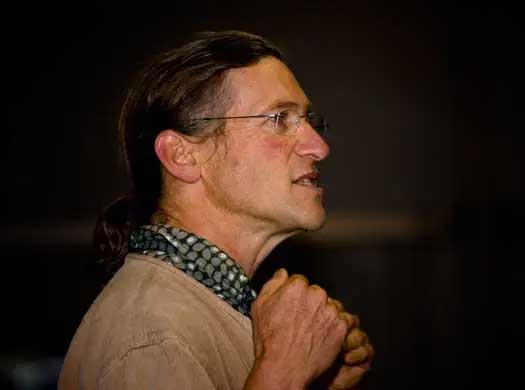
David Holmgren makes a point.
After matriculating from John Curtin Senior High School in 1972 he spent a year hitchhiking around Australia before moving to Tasmania in 1974 to study environmental design (but gravitating towards landscape design, ecology and agriculture). It was during the brief but intense association between Mollison and Holmgren, thrashing out ideas in Mollison’s lounge room on the lower slopes of Mt Wellington — what became known as ‘the republic of Strickland Avenue’ — that the backbone of the permaculture concept was formed.
Not all that long after devising the original concept of the permaculture design system, David started the work of setting up his rural smallholding – Melliodora — at Hepburn, a small town in Victoria.
No positive direction forward
Mollison wrote of those times: “To many of us who experienced the ferment of the late 1960s, there seemed to be no positive direction forward, although almost everybody could define those aspects of the global society that they rejected. These included military adventurism, the [nuclear] bomb, ruthless land exploitation, the arrogance of polluters and a general insensitivity to human needs. An unethical world could waste more on killing people than on earthcare or on helping people.
“From 1972 to 1974 I spent time, latterly with David Holmgren, in developing an interdisciplinary earth science – permaculture – with a potential for positivistic, integrated and global outreach.”
build an army of permaculture field workers to go out and teach the ideas of sustainable food production
Mollison has said more recently that, by the late 1970s and following the Club of Rome’s reportLimits of Growth, there was increasing concern from governments and bankers about the world running out of resources.
“But no one had any long-term ideas and it was obvious to me what had to be done,” he said. “That was to build an army of permaculture field workers to go out and teach the ideas of sustainable food production.”
Nature and the intellect
For his part, Holmgren was attracted to the natural and intellectual environment of Tasmania. He was also lured by Tasmania’s Environmental Design School that was led by Hobart architect and educator, Barry McNeil. This, Holmgren says, at that time was “the most radical experiment in tertiary education in Australia”, attracting design students from around Australia and the world.
Tasmania… it is a place where modernity and nature collide, both destructively and creatively
“In this intellectual hothouse I met Bill Mollison, whose life and ideas epitomised a creative bridge between nature and civilisation and between tradition and modernity,” Holmgren wrote.
Holmgren says he is sometimes asked why permaculture emerged from somewhere like Tasmania. His answer: “It is a place where modernity and nature collide, both destructively and creatively.”
That can be seen along the edge, the zone, where the city of Hobart collides with the tall eucalypt forests that clothe the lower slopes of Mt Wellington. The mountain, with its precipituous dolerite cliffs known as the Organ Pipes. is occasionally snow capped in winter where it catches the moist, cold winds known as the Roaring Forties. It dominates the city, a presence both physical and in the minds of locals who intinctively look up to the summit for some indication of the weather or, perhaps, to remind themselves that they inhabit one of the most geographically beautiful cities in Australia. On its lower slopes, below the olive green of those euclaypt forests, is the property where the permaculture concept was born. A few kilometres in one direction is the city centre. In the other, well beyond the horizon, the great cool temperate wilderness of South West Tasmania.
Wilderness the South West might be, it was not inviolable and the politically powerful Hydro-Electric Commission was looking enviously – at the time that permaculture was being hatched – at its wild rivers and thinking about damming them. The Hydro had already inundated Lake Pedderbelow the grey, wind-whipped surface of a dam’s empoundment, an action that lay almost forgotten behind the emergence of green politics in Australia.
This gave rise to a growing environmental consciousness that developed in Tasmania at that time, but it was a consciousness seemingly unaware of permaculture ideas, being oriented towards wilderness preservation and nature conservation. When that consciousness became self-conscious and formed the early Tasmanian environment movement, it moved into oppositional politics, the threats to the environment perceived to be so great. This was the start of a mass movement that would culminate in the victory on the Franklin River.
Just how much the early environment movement fed the emerging permaculture concept is unknown, but it surely prepared the field for it in a conceptual and ideological way. On the lower slopes of Mt wellington, Bill Mollison was surely aware of that movement’s gathering strength.
Holmgren acknowledges this, saying that “the physical and cultural environment that gave rise to permaculture also produced the world’s first green political party.” In 1972 the United Tasmania Group (UTG), which evolved to become the Tasmanian Greens, was formed.
UTG was the first authentic green party in as much as it had environmental politics at its core. But whether it should be regarded as the first political party with an environmental policy remains open to dispute.
“I was living in Tasmania at the time”, permaculture educator and writer Russ Grayson says, “and figured among my friends and associates some who would later gain prominence in environmental politics in the state.
“I remember conversations with a UTG member, Des Shields, originally a Queenslander, who told me about the earlier work of the New Zealand Values Party which, while not ostensively a green party, had an ecological element to their platform. Des, I think, may have regarded this party as the first green party in history.”
Holmgren says the Australian organic agriculture movement also sprouted in Tasmania, part of, “An upwelling of intellectual and creative action at the edge of civilisation.” In fact Mollison was a founding member of the Tasmanian Organic Gardening and Farming Society, the same organisation from which Peter Cundall, who decades later was to host ABC television’s Gardening Australia emerged.
The island state, it seems, may have been instrumental in giving birth to more than one innovative social movement.
1976 – 1981 – spreading the word
Permaculture made its first appearance on the world stage in 1976 in an article in Tasmania’s Organic Farmer and Gardener newsletter published by the Tasmanian Organic Gardening and Farming Society. It was titled A Permaculture System for Southern Australian Conditions – Part Oneand was written by Bill Mollison and David Holmgren.
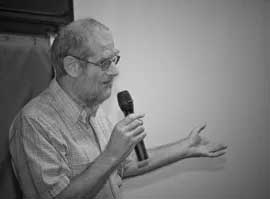
Max Lindegger in 2008. Max was one of the team that established Crystal Waters Permaculture Village in SE Queensland and was instrumental is spreading permaculture in Australia in its early years.
On the mainland, Mollison was interviewed on national radio by Terry Lane. What followed was an avalanche of interest and controversy.
A key permaculture pioneer in Australia, Max Lindegger, who went on to design the world’s first permaculture eco-village, Crystal Waters, said it was an electrifying time. Max, living thousands of kilometres to the north in Queensland, read that first article and realised that ” …it was exactly the way I felt but had been unable to put into words” – a common sentiment of people then and even now. He invited Mollison to come north for a speaking tour.
In 1976 Max formed what may have been the second permaculture group in existence, Permaculture Nambour. Meetings were at his home, and, interestingly, he still gets mail there for the organisation.
The permacultural concept has caught the imagination of hundreds of people in Australia… it may well have a wider impact…
Permaculture was starting to attract attention, but it took another two years for this rich ferment to produce the first book on permaculture – Permaculture One – a Perennial Agriculture for Human Settlements. It was published in 1978 by Transworld, with joint authorship to Mollison and Holmgren.
In the book’s introduction the authors comment: “The permacultural concept has caught the imagination of hundreds of people in Australia where we have given verbal descriptions and short resumes of the system. It may well have a wider impact, as the time seems ripe for such a synthesis in a world of famine, poisons, erosion and fast-depleting energy.”
The year 1978 is a significant one for the permaculture design system. As well as Permaculture One, also appearing in that year was the first permaculture magazine – initially called, simply,Permaculture. Its editor was Terry White, a resident of the Victorian town of Maryborough, on Australia’s mainland.
Of the Mollison-Lane radio interview, White says: “I found it galvanising. Bill’s interview kindled my imagination in a profound way.” So much so that White invited Bill to visit Maryborough for a public meeting
“At that time”, says Terry, “there was a lot of concern about youth unemployment. In an attempt to address this, Maryborough had started two employment cooperatives, one making clothing and the other making bicycle trailers. An alternate technology foundation was planning the establishment of a technology demonstration centre and there was considerable concern over dryland salinity, which was attributed to the removal of trees and the subsequent rise in saline groundwater in the area.
Maryborough… a significant hub for the permaculture movement for its first ten years
“It was this context of concern about youth unemployment and land degradation that provided a responsive setting for the discussion of permanent culture – permaculture – and an emphasis on positive, practical whole-system solutions.
“Permaculture One was printed in Maryborough”, said Terry White, “ …and Maryborough remained a significant hub for the permaculture movement for its first ten years. The town hosted two permaculture conferences and two of the first ten day permaculture consultancy courses”. The first permaculture course had been held in Tasmania in 1978.
More than Maryborough
According to David Holmgren, it wasn’t just Maryborough that was ready for the permaculture message.
“At the time there was an upheaval in new, positive environmental solutions as a response to a sense of crisis, especially the energy crisis”, he says. Concern over the energy supply was the outgrowth of the OPEC-led reduction in the supply that triggered the oil crisis of 1973, and which led to rationing in some Western countries.
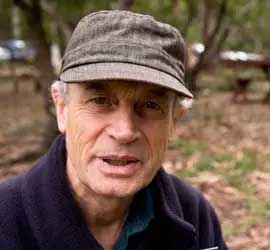
The work of Terry White was critical to permaculture’s early development.
White says that people were receptive to Mollison because, ” …he stood for something rather than against things.
“Bill had positive, practical solutions to problems… to real problems. He came across as a doer, not a talker. He proposed that instead of waiting for government or for funding, we just go and do whatever it was that was necessary. People found this approach empowering… it released energy. Permaculture might have been seen as a bit fringe but it was hands-on.
“While in Maryborough, Bill was invited to visit the tip and the sewage settling ponds. His suggestions for the productive use of wastes from these two sites were taken seriously by the council and a plan for the productive use of sewage waste was published in the first edition of thePermaculture quarterly journal of the national permaculture association.
“I was attracted to Bill’s idea of seeing problems as solutions, of reframing questions as positive solutions. There was also permaculture’s systems approach – it’s holistic way of looking at things.
“Permaculture, to me, is a community development model… a grassroots approach”.
Impetus from the Maryborough meeting led to another of the earliest permaculture groups in Australia, and then the National Permaculture Association.
“Before that”, says permaculture early adopter-now-Permaculture-educator, Robyn Francis, “Bill Mollison spent 1976 and 1977 overseas, collecting ideas that would find a place in the still-developing permaculture idea”.
Wit, provocation and charisma
Mollison is renowned for his wit, provocative style and charisma, and all were in full force at the time. Lindegger remembers the first permaculture design course, taught by Mollison over three weeks in 1979, with 18 participants ‘invited’ from all parts of the country. The venue was an old hotel in Stanley.
He says the impact on those involved was life-changing and many became a driving force for the movement. Tens of thousands of people have since taken design and introductory courses, going on to work on projects or in their communities around the world.
In 1979, Mollison published Permaculture Two, focussing on design. In 1981, still in the early days of permaculture, he received international recognition with a Right Livelihood Award, sometimes called the ‘alternative Nobel Prize’. In his acceptance speech, he said: “All my life we’ve been at war with nature. I just pray that we lose that war. There are no winners in that war…”
The 1980s – binding a growing network
The publication of Permaculture magazine was pivotal to the history and spread of the design system. Like its eventual successor, the Permaculture International Journal (PIJ), it bound together a geographically dispersed network of emerging permaculture practitioners. Permaculture was the first publication to highlight the important role of the media in the spread of the design system. That would be more than amply demonstrated over 15 years later with the broadcast of the Global Gardener television series.
When White handed Permaculture over to Robyn Francis in 1987, the magazine moved to Sydney. At the Permaculture Epicentre in inner-urban Enmore (now Alfalfa House Food Coop), in a building shared with a small permaculture shop and Australia’s first ethical investment company, Damien Lynch’s August Investments, a team of media volunteers typed, cut and pasted articles and images into pages of what soon became the International Permaculture Journal.
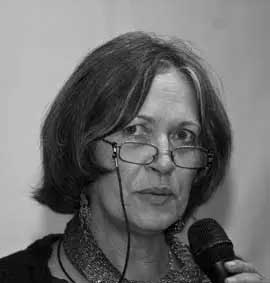
Robyn Francis, one of the design system’s early adopters, has made a career of permaculture education.
Soon, Permaculture Edge appeared, produced by a Permaculture Nambour in south-east Queensland. After a few years of increasingly sporadic publication, Permaculture Edge disappeared after its last edition went on sale at the 1997 International Permaculture Convergence in Western Australia.
The Permaculture International Journal (PIJ), as it became known after Robyn Francis assumed editorship and, later, handed that role to Steve Payne – now editor of ABC Organic Gardenermagazine – remained the mouthpiece of the design system although, in the 1990s, Green Connections, which also reported on permaculture, came on the scene. That magazine ceased publication in December 2000, six months after PIJ.
Significantly, PIJ became the first permaculture publication to go mainstream, quite some time before Green Connections. “That was when it became available on the news stands”, says Robyn Francis.
With the turn of the decade, news of the permaculture design system was spreading and, according to White, by the mid-eighties the ten permaculture groups in Australia had grown to around 80 worldwide. In 1987, with key input from Robyn Francis, Permaculture International Ltd was incorporated to expand the distribution of Permaculture International Journal and to support the growing global network.
Permaculture also continued to be advanced through books, in particular, Mollison’s 1988, 576-page cornucopia of ideas, Permaculture – A Designers’ Manual, self-published by his own company,Tagari.
Soon, permaculture’s early adopters were teaching the design system. There was Max Lindegger, and Robin Francis, today based at the Djanbung Gardens training centre in northern NSW, who taught her first Permaculture Design Course in Sydney. She was instrumental in having an elective subject in permaculture accepted in the TAFE horticulture course at Ryde College.
Enter Rosemary
“Janice Haworth said there was going to be a permaculture course with Robyn Frances at Newtown and that I might like it,” she says. “I was suspicious at first but soon realised that it was the approach that enchanted me… it was interactive and overlaid with interconnection of disciplines.”
The different Permaculture Design Courses were often quite erratic.
The Blue Mountains are less that two hours from Sydney by train but they might as well be on the other side of the continent, they are so different. Lifted above the lowlands to their east and west, the mountains are an ancient sandstone plateau dissested by deep river valleys and clad in the olive green of eucalypt forest. Rainforest inhabits the darker, wetter gullies. Rather than the warm temperate climate of the coastal plain, the altitude of the mountains creates a microclimate more akin to the the cool temperate of the southern states.
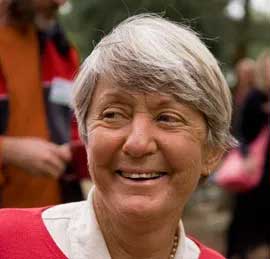
Rosemary Morrow
The town of Katoomba is the largest of the small towns and villages strung along the Great Western Highway where it crosses the Blue Mountains. And here, in a modest brick veneer house that she is refitting for energy and water efficiency and home food production, lives a woman who has accomplished much permaculturally, Rosemary Morrow.
Rosemary became a Quaker in 1978, she says, the year that Permacultre One was published. She describes her discovery of permaculture.
The different Permaculture Design Courses were often quite erratic
Rosemary recollects the early days of permaculture.
“Well, they were chaotic really. The information was all over the place and some of it was relevent then, but today it’s quite dated. Some of the claims were extravagant and not realistic. It all sounded so simple.
“It took me ages to realise that design was the main subject and that Network Science was the key to it all. My background in agricultural and environmental science and horticulture helped me to make sense of it at a deeper level. It was very attractive because it put all these in the same frame.
Permaculture became my vocation
Rosemary tried to make order from confusion and explains that permaculture education has changed from its early days.
“The different Permaculture Design Courses were often quite erratic and no one had a sense of the skills and knowledge they wanted participants to have by the end of the course. It was taught by enthusiasts with no teaching skills. Copying Bill Mollison meant a 72 hour talkfest which few could emulate. That’s pretty well changed now.
“I was also intrigued by a course which began with ethics… none of my other studies had ever mentioned the word. There was a correspondence between Quakerism and permaculture. They had in common things like care for people, simplicity, community, ethical use of money and right livelihood. I was at home.
“Permaculture became my vocation and the more I worked with the content, the more interesting and the deeper it went… links started to happen with special nodes around water, plants and soil. I saw design as philosophy and practice and the true subject of the course.
After discovering permaculture, Rosemary went on to take its ideas to Vietnam and Cambodia and to other places. Today, she teaches the design system in the Blue Mountains, where she lives, and promotes the virtues of localism. Rosemary has built a network of local permaculture practitioners.
She has also become an author of permaculture books. First, in the mid-1990s came the Earth Keeepers Guide to Permaculture, then a teacher’s manual based on the content of that book. Later, she wrote a manual on saving seeds for use in developing countries. On a sunny late Autumn day in 2006, a new, updated edition of the Earth Keepers Guide was launched amid the sweet white blossoms of the heritge apple tree collection in the Blue Mountains Community Garden.
Growth continues
“The 1980s were a period of growth for Permaculture”, says Francis.
“The decade started with the Alternative Economic Summit in 1984 – which introduced permaculture to economics – and in 1987 August Investments made a start.
“We had the the Earthbank Conference – that was the outcome of Bill talking with the Schumacher Society. There was the establishment of the Maleny Community Credit Union, the first and second international permaculture convergences, the first permaculture design courses in Nepal, India and Zimbabwe and then the third international conference in New Zealand.
“There was the opening of Crystal Waters Permaculture Village, Australia’s first ecovillage, a project driven by Max Lindegger (now with the Global Ecovillage Network) and his team.
“Declan and Margrit Kennedy, in Germany, taught the first urban permaculture course, for the first time taking permaculture beyond the rural. Canadian, Michael Linton, introduced LETS (Local Exchange and Trading System) to Australia. In 1988, Bill taught the first permaculture course to an Aboriginal community at Alice Springs and the decade culminated with the publication of Bill’sPermaculture – A Designers’ Manual, the most substantial of permaculture texts and one still in print.”
It was late in the decade that the design system appeared on the tube in front of a mass audience, thanks to the ABC (Australian Broadcasting Corporation), an event that sparked wider interest in the permaculture agenda. Two early programs featured Bill and permaculture, one entitled In Grave Danger of Falling Food and another, a permaculture garden makeover, shown on the Extra Dimensions program.
The Manual, along with a cut-down version, Introduction to Permaculture (1991), still sells well today. Among Mollison’s other books, which collectively have sold more than 100,000 copies worldwide, are The Permaculture Book of Ferment and Human Nutrition (1993) and his autobiography, Travels in Dreams (1996). Mollison was rumoured to have been working on a number of other publications in recent years but none have yet been published.
1990s – years of consolidation… and expansion
The decade started well for permaculture as it continued to spread its influence. It was growing overseas, too, in both developed and underdeveloped countries. In Australia, the PIJ held the movement together, providing it with the news and information that bound it into a diffused but coherent movement.
Permaculture was still far from mainstream but it was gaining in respectability and credibility. Change, however, was only ten years away.
“The 1990s brought further growth”, Robyn Francis continues. “My own project, Jalanbah Ecovillage, made a start in rural Nimbin, as did my permaculture teaching base and permaculture demonstration centre, Djanbung Gardens”.
The Australian City Farms & Community Gardens Network was operating by mid-decade, promoting community-based urban agriculture as a venue for permaculture and associated ideas. Notable also was another television program, the four-part Global Gardener series shown on the ABC, which swelled attendance at permaculture courses.
“In Sydney, the television broadcast of Global Gardener boosted attendance at our permaculture introductory and Permaculture Design Courses, something that other educators reported too,” said Fiona Campbell, who led a Sydney-based permaculture education team that developed a 110-hour, part time urban Permaculture Design Course. “More so that the earlier television programs about permaculture, Global Gardener brought permaculture before a mainstream audience in a powerful way”.
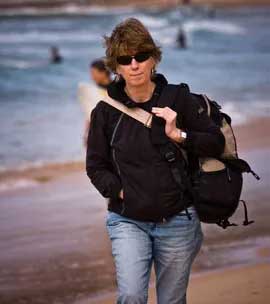
Fiona Campbell led a permaculture teaching team which developed an urban Permaculture Design Course in Sydney in the 1990s and worked with the Permaculture Sydney association.
By this time Mollison had established for himself a reputation as the visionary communicator of permaculture. He stirrer his audiences and was the outspoken public voice of the design system, a reputation he had built over the previous decade. He travelled widely to deliver the permaculture message to audiences both eager and curious.
Holmgren re-emerges
While Mollison was increasing his public presence, Holmgren remained largely out of the public eye, quietly and busily testing permaculture principles on his own property at Hepburn Springs, a couple of hours from Melbourne.
In 1995 Holmgren published a documentation of those years on the land in the form of the large format book, Ten Years of Sustainable Living at Melliodora. This set out in detail the creation of his productive small farm and permaculture demonstration site that included a passive-solar sustainable home, contour planting and tree crops.
Other case studies and writings followed, including case studies of Holmgren’s integrated house and landscape designs in south eastern Australia. Most recently, the landmark 2002 publication,Permaculture – Principles and Pathways Beyond Sustainability has appeared. Popularised through a speaking tour that promoted the book, it quickly captured the permaculture imagination. The book offered a reinterpretation of the design principles of permaculture and Holmgren’s are now more frequently cited than the earlier set although they in no way disagree with it.
Permaculture – Principles and Pathways and Holmgren’s national tour to promote it did more than remind the permaculture network that David was still there, applying the design system on his own land, overshadowed by Bill’s public presence though he might be. It marked the emergence of Holmgren as the most prominent authority on permaculture in the country, a reputation increased later by his speaking tour with US peak oil writer, Richard Heinberg.
The popularity of Permaculture – Principles and Pathways rests on Holmgren’s reputation as a permaculture pioneer and its serious approach to design concepts. This, despite the appearance of other permaculture books in the period between the publication of Mollison’s Designers Manualand Holmgren’s book. There was West Australian permaculture educator, Ross Mars’ introductory volume and Patrick Whitefield’s books in the UK. Significantly in Australia, Rosemary Morrow’sEarth Users Guide to Permaculture was published in themid-1990s, a book which, thanks to being written in her down-to-earth style, achieved status as a recommended text for a number of Permaculture Design Courses.
In recent years Holmgren has ‘come out of his shell’, speaking and lecturing around the world on permaculture and peak oil and sharing the platform with prominent environmental activists such as Richard Heinberg. He continues to live with his family at Melliodora.
Going home
The Tweed Range falls as a rugged, precipituous escarpment clad in subtripical rainforest to the less-precipituous but still steep hills that abutt it. Over the generations farmers have opened the country, clearing those hills to graze their cattle. It was this rolling country that attracted Bill Mollison and led to his establishing the Permaculture Institute on a 2ha block near the end of a narrow, dusty road not all that far from the town of Tyalgum.
Here, Mollison and others living on the site rehabilitated the old farmland with tree and vegetable crops as an example of rural permaculture design. Within a few years the adjining farm went on the market and Mollison bought this, setting up the Permaculture Research Institute.
An experiment with a Permaculture Commonworks was launched, a scheme through which individuals were given access to land, for a fee, on which they would set up income-producing enterprises. A market garden appeared down on the flat land by the creek; a bamboo plantation was started to supply shoots to the food market and to market bamboo stalks; a large, free range chicken system was fenced; a hillside was terraced and tropial fruit trees planted; and a large dam was seeded with edible fish. The scheme seemed to thrive for awhile on the enthusiasm of those setting up the enterprises. Within a few years, however, it had collapsed.
It was now the late-1990s and it was a time of change for Mollison. Having lived for many years on the Institute property in the sub-tropics, he returned home to Tasmania to write and occasionally teach.
The Permaculture Research Institute he handed over to Permaculture designer, Geoff Lawton and his team. When the property was sold, Lawton reestablished the Permaculture Research Institutenear The Channon, in northern NSW, not all that far from where Mollison had originally set it up.
Mollison now lives with his wife, Lisa, at sisters Creek near Deloraine in northern Tasmania… his homeland and not all that far from his humble beginnings in Stanley.
Permaculture – established at last
Permaculture is now mainstream in Australia, at least in gardening and environmental circles, with ‘permaculturists’ on national television and writing for major publications.
Key breakaway movements, now also mainstream, were inspired by permaculturists in Australia, from ethical investment to community gardening and the national Seed Savers Network. Some, like community gardening and city farms, were not originally established as permaculture projects, however permaculturists soon found them fertile ground in which to implement their ideas.Northey Street City Farm in Brisbane, set up in 1994, has perhaps taken the link with permaculture the furthest with permaculture educator, Dick Copeman, offering the recently-national accredited certificate courses in permaculture as well as the traditional Permaculture Design Course.
Holmgren believes permaculture’s popularity to be at least partly due to its comprehensive nature as “ …a design system for sustainable living and landuse that’s concerned both with the consumption and production side and that’s based on universal ethics and design principles which can be applied in any context.
“It’s a grassroots, international movement of practitioners, designers and organisations – networks”, he concludes.
Numerous books have been written here by other permaculture teachers and there has been a coming together of permaculture and organic gardening groups into a strong and vibrant force for the future.
Going international
The road from the coastal plain is long, narrow and dusty. Towards its end it rises through farmland and eucalypt forest and ends abruptly in front of an old, weathered timber building at a place called Pappinbarra. Here, in 1984, at its first international convergence, permaculture was born as an international movement. Present were permaculture’s early adopters, the people who would take the design system to the world.
The international story of permaculture is so diverse and idiosyncratic, it is impossible to throw a net over it. Certainly, an army of field workers has taken the design system far and wide (as Mollison set out to do), even if many no longer wear the public cloak of permaculture, preferring to use its principles within their occupations or community work – whether farmer, architect, planner, simple gardener or community activist.
More recently, permaculture has started to infiltrate the new local government area of sustainabilitty education, although this is taking place only in limited areas such as among some NSW councils. Why the development is significant is because the predecessor approach to local government community education — environmental education (the actual meaning of the terms is somewhat fluid) — has focused mainly on the conservation of the natural environment, water and waste.
Even in the 1980s, without the aid of the internet, word of permaculture spread rapidly.
The first International Permaculture Conference was held in Pappinbarra, Australia in 1984, kick-starting its international outreach.
The second international conference took pace at The Evergreen State College, Olympia, Washington (USA) in 1986 and featured not only Mollison, but famed Japanese natural farming pioneer, Masanobu Fukuoka (author of The One Straw Revolution), and Wes Jackson, founder in 1976 of the Land Institute (researching perennial agriculture in the USA).
Guy Baldwin, founding editor of The Permaculture Activist magazine (launched in 1985 and still going), says the conference was pivotal in bringing permaculture to a mainstream audience in the US although courses and talks had already been held there and a key networking organization, the Permaculture Institute of North America, had been formed.
There is still strong activity in permaculture circles in the US although Baldwin believes that, to some extent, “the momentum started by permaculture in the early 1980s was largely swallowed up by activism in other ‘alternative’ movements such as organic farming, sustainable agriculture and deep-ecology.” Nevertheless, he remembers a great buzz around the international conference which led to many courses and further visits from Mollison.
Outside the US there have been conferences and courses in diverse locations, including New Zealand, Nepal, Zimbabwe and Denmark. The New Zealand conference included cosmologist, Paul Davies, and Ecologist magazine founder, Teddy Goldsmith, as keynote speakers. The latest international gathering was held in São Paulo Brazil in May (2007), featuring alternative and innovative thinkers from around the world.
Many countries now have their own peak permaculture bodies and publications, among them thePermaculture Activist and, in the UK, Permaculture. Although PIJ is no longer published, thePermaculture International organisation remains, maintaining a website and a global directory as networking tools.
Permaculture’s future
Rosemary Morrow describes how she sees the future of the design system in an upcoming book of biographies of people with a history in permaculture.
“I view permaculture today as still a prototype. It is barely thirty years old and continues to grow and stretch out into people’s lives and take forms of its own, especially if we think how David Holmgren has stretched the parameters.
“I remember Mollison saying to me ‘permaculture is about tangibles.’ Today I see the tangibles embedded in intangibles… the conversations, the solitude, the insights, reflections and feedback and new findings in every part of the Permaculture syllabus”.
……Bio notes: Russ Grayson is a journalist who has taught permaculture design, worked on international development projects and is active in food security issues in Australia. Steve Payne is editor of Organic Gardener magazine in Australia and was a former editor of the Permaculture International Journal.












评论已关闭